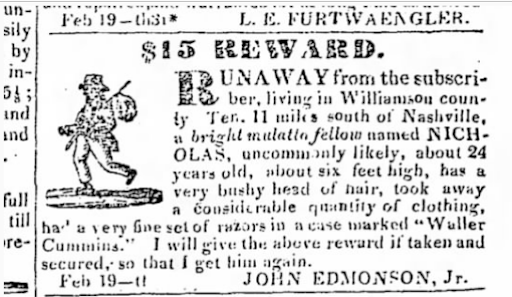Every February we as Americans celebrate the contributions of Black Americans to our shared history. Through many adversities, the perseverance and strength of Black Americans was illustrated by these contributions. Communities all over the country were built from the ground up. This consisted of neighborhood, business, religious, social and political communities. Williamson County was no different. Learning about and appreciating our Black neighbors and friends’ contributions gives a fuller understanding of our American narrative.
Slavery was a major industry in Williamson County from it’s settlement in the late 18th Century through the 1860s. Slaves were bought, sold and rented out regularly. In Franklin, slaves were sold on the town square. The slave market house was located in the center of the town square attached to the courthouse. When a new courthouse was built on the south side of the square, the market house was left standing alone. It was knocked down in December of 1855 by a severe storm that passed through the area.
Slaves did not submit to slavery without resistance. Some, like Judah Scott, were able to purchase their freedom. Others ran away to start a new life. Freedom was the ultimate objective.
Freedom for the enslaved of Williamson County ultimately was achieved after the American Civil War with the passing of the thirteenth amendment. The choice was now their own as to the next chapter in their lives. Simple choices like who they married and where they lived became their own. Some would head north in search of a new start. Many headed west, looking for land and opportunity, however a great number remained right here in Williamson County.
The Freedmen’s Bureau, a branch of the U.S. Army, created an office here in Franklin. Their job was to ensure that the recently freed men and women were not taken advantage of in their new situation. They helped to build schools, churches and oversee the creation of labor contracts. Labor contracts were a very common arrangement during the Reconstruction period. They were agreements on conditions of emplyment between former slaves and either their previous owners or another employer. Here is an example of a labor contract between John McGavock of Carnton and Thomas Neely.
The post war years were filled with a new normal and an entire population of individuals learning how to navigate this new normal. No one knew how it was going to work. The unknown is scary. Emotions like fear, tied in with resentment and anger create hostile climates. The climate in Williamson County was comparable to many other cities in the south. Next week, in the blog, we will dive into the Franklin Riots of 1867 and the arrival of the Ku Klux Klan.
Mint Juliet
- Broadside, TSLA
- The Tennessean,Nashville, Tennessee, 19 Feb 1835, Thu, pg.3
- Williamson County, In Black & White, Williamson County Historical Society, Journal No. 3, 2000, pg. 63




